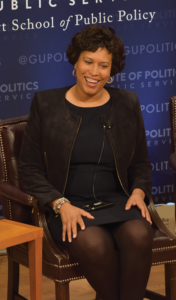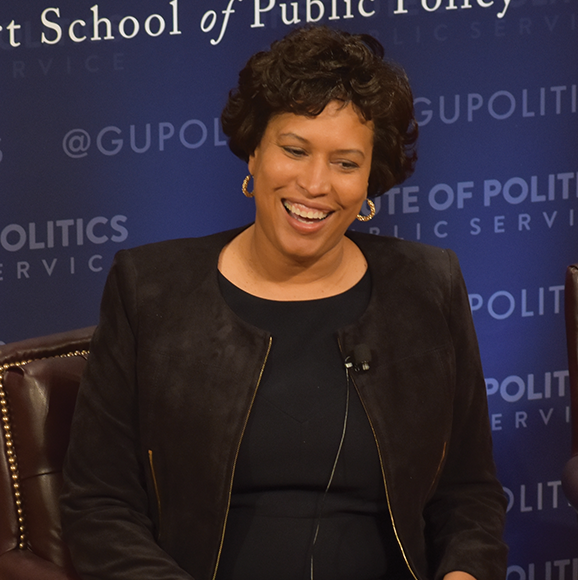
Investments in housing can address Washington, D.C.’s affordability issues as the city’s population booms, D.C. Mayor Muriel Bowser (D) said at a Jan. 22 panel of mayors in Lohrfink Auditorium.
The third annual “Georgetown Mayors Forum” featured Bowser; Mayor Nan Whaley of Dayton, Ohio; and Mayor Elizabeth Kautz of Burnsville, Minn., in a panel about innovation, infrastructure and inclusion.
The Georgetown University Institute of Politics and Public Service hosted the event in collaboration with the Georgetown University Global Cities Initiative with Sheila Foster, a featured professor of law and public policy, as the moderator.
Despite representing cities ranging from 60,000 to over 600,000 in population, the mayors agreed that joint efforts between community members and local governments are important in resolving concerns, according to Kautz.
“All of us have the same issues, they’re just in different degrees,” Kautz said. “The thing that you have to do is that you do have to talk to people, whether it’s a city my size, Mayor Bowser’s, or Mayor Whaley’s, it’s all about how you approach those tasks intentionally.”
Advisory Neighborhood Commissions, locally elected nonpartisan bodies that advise the District government on issues affecting neighborhoods, provide a way for members of D.C. communities to engage with the local government. The effectiveness of the ANCs relies on high engagement and the support of the D.C. government, according to Bowser.
“I value the input of the Advisory Neighborhood Commissions and I certainly think they are called on to do more and we are called on to give them the tools they need to be effective,” Bowser said.
Two Georgetown students, Matias Burdman (COL ’21) and Anna Landre (SFS ’21), were recently elected to ANC 2E, which oversees Georgetown University, Burleith, Hillandale and Georgetown.
The ANC system can take away from what is best for D.C. as a whole, however, because at times each individual commissioner’s focus is on their own district, Bowser said.
“The one hole you can encounter with ANC commissioners is that people are micro-parochial, not just on a ward level, but on a Single Member District, 2000-person level,” Bowser said. “Sometimes the benefits that they may negotiate for a particular development don’t contribute to bigger city issues.”
Partnerships between local governments and private sectors can lead to improvements in affordable housing, according to Kautz. When Burnsville, Minn., turned over the land of a neighborhood with high crime rates to a housing development company on the condition that 20 percent of the housing was made affordable, crime in the area shrank, according to Kautz.
“This was about bringing people together, the property owners as well as all of the developers, and asking the question ‘What do we want our city to look like?’” Kautz said. “For me, it was about creating an urban center, creating a pedestrian-friendly environment, as well as making sure that everyone is welcomed.”
As costs of living and housing increase in D.C., low-income black families are being pushed out of their homes, according to The Washington Post. This summer, residents of D.C. filed a class action suit against the District for discriminatory housing policies. The plaintiffs accused the city for supporting gentrification that disproportionately hurts communities of color.
The issue of limited affordable housing should not only be addressed by the D.C. government, but also at the neighborhood level, according to Bowser.
“We want to encourage growth and attract people and good jobs, but it does make everything so much more expensive, and housing is the key,” Bowser said. “I’ve challenged our whole city to think even bigger and we’re asking everyone to be a part of the solution by adopting goals for each neighborhood.”
Engaging community organizations with local government also helped address the opioid crisis in Dayton, according to Whaley. The alignment with local community organizations led to a 50 percent drop in fatal overdoses over a year, according to The New York Times.
“We aligned the entire community, over 60 different organizations came to the table and said we’ve got to do whatever we can to really deal with the issue of addiction like the disease that it is,” Whaley said. “The collective-impact model is something that I think is the best model for all sorts of issues, from education to addiction issues.”





















